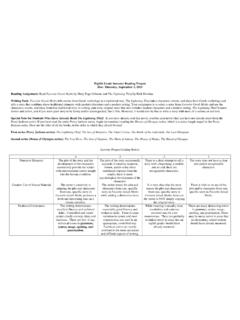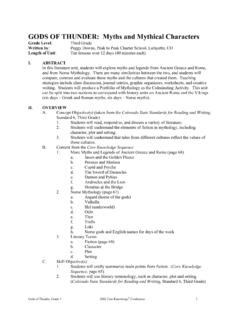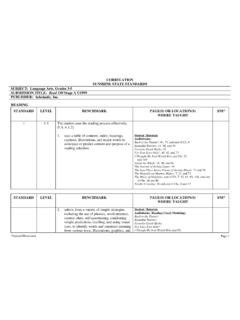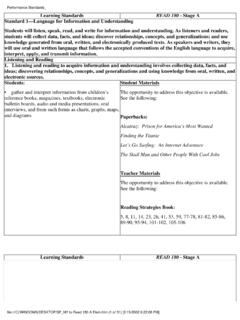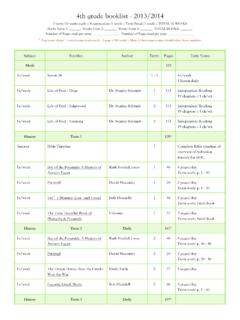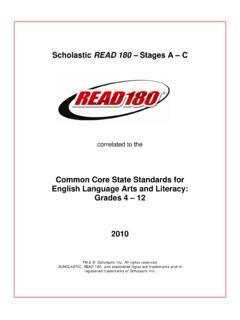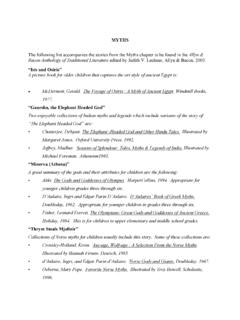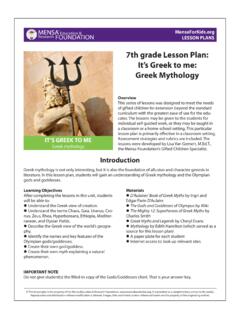Transcription of Tales from The odyssey - books.disney.com
1 B!C50%This guide is aligned with the College and Career Readiness Anchor Standards (CCR) for Literature, Writing, Language, and Speaking and Listening. The broad CCR standards are the foundation for the grade level specific Common Core State GUIDED isney HYPERION BOOKST ales fromThe odyssey2 About This GuideThe Tales from the odyssey stories have has such rich symbolism, amazing action, and extraordinary characters that there seem to be limitless activities teachers can use to enhance their students reading and learning. This guide will give focus and direction to teachers, so they can lead and mentor their students in the particular areas that reflect their students needs and abilities. There are whole-group activities and discussion questions, activities for small groups, and activities for independent, individual student efforts. The suggested activities focus on various learning modalities so that teachers can select the activities that best fit their students learning styles and strengths.
2 Pre-reading ActivitiesWhat is an epic?An epic is a long narrative poem that recounts the deeds of legendary or historical heroes. The greek epics were originally part of a purely oral tradition. They were sung by wandering entertainers called rhapsodes, who improvised performances of their Tales using a special verse form called epic meter and accompanying themselves on a simple harplike instrument called the cithara. In those days, every sung version of an epic was different. But at some time, probably beginning in the eighth century BCE, as the practice of singing the epic Tales was beginning to die out, the epics were written down. Two of the most famous greek epics are the Iliad and the odyssey , which were originally part of a vast cycle of similar poems, most of them now known only in fragments. The Iliad tells the story of the Trojan War, and the odyssey recounts the adventures of Odysseus, king of the island of Ithaca, on his long journey home from that war.
3 The Greeks loved the Iliad and the odyssey , which became central to their literary education. 3 What is a greek myth? A greek myth is a story about the powerful gods and goddesses of ancient Greece. Some of these stories were first told to explain natural phenomena like the weather, volcanoes, and the constellations. Others were an important part of the ancient Greeks religion. These stories later became important sources for greek poetry, art, and theater. They have continued to inspire writers and painters up to the present day. The oldest written versions of the greek myths are found in the Iliad and the odyssey . Who was Homer? Homer is the name traditionally given to the composer of the Iliad and the odyssey as they have come down to us. Scholars are not sure if Homer was a real singer or a legendary one, or if there were several singers who shared that name. Many scholars believe that Homer was a famous rhapsode who lived around 850 BCE nearly three thousand years ago.
4 Like many other famous epic singers, he is said to have been blind. What was the odyssey s original written form? The odyssey was composed in a dialect of ancient greek . It was originally written down in twenty-four parts, or books, in long flowing lines that did not rhyme at the end, in the special rhythm called epic meter. Technically, this meter is called dactylic hexameter. The odyssey has been translated into many languages, in both verse and prose. 4 The Ancient GreeksThe ancient Greeks were polytheists, people who believed in many gods and goddesses, each of whom ruled over a particular aspect of the world. There was a god of the sea, a god of war, a god of love, and so forth. But the god believed to be the most powerful of all was Zeus. Zeus was the god of thunder, and he was said to rule the entire mortal world and the heavens. The Greeks believed that Zeus lived on Mount Olympus and that all the other gods and goddesses were his relatives.
5 He also had a wife, Hera, the queen of the gods and goddesses. The Greeks also believed that these gods and goddesses visited the earth, and that they became involved in people s daily lives. A list of the greek gods and goddesses will help you become familiar with their names and domains. greek Gods and GoddessesZeus: king of the gods and goddesses, god of thunder Poseidon: brother of Zeus, god of seas and rivers Hades: brother of Zeus, king of the Land of the Dead, the Underworld Hera: wife of Zeus, queen of the gods and goddesses Hestia: sister of Zeus, goddess of the hearth Athena: daughter of Zeus, goddess of wisdom, war, and arts and crafts Demeter: goddess of crops and the harvest, mother of Persephone Aphrodite: daughter of Zeus, goddess of love and beauty Artemis: daughter of Zeus, goddess of the hunt Ares: son of Zeus, god of war Apollo: god of the sun, music, and poetry Hermes: son of Zeus, messenger god Hephaestus: son of Hera, god of the forge Persephone: daughter of Zeus, wife of Hades, queen of the Land of the Dead, the Underworld Dionysus.
6 God of wine and madness 5 Discussion QuestionsWhen sharing the following activities with students, encourage them whenever possible to refer to specific passages from Mary Pope Osborne s Tales from the Students Understand a Writer s Research The odyssey was written down more than three thousand years ago. Many people have retold this famous story. Mary Pope Osborne read and referred to many retellings of the odyssey as she researched and prepared to write. 1 Why would someone consult numerous translations? 2 What happens when people translate from one language into another? 3 Why would one writer choose different words from another in describing and telling the same story? 4 Why would different writers create and allow differences in interpreting a story? Common Core ConnectionsThe discussion questions and activities in this guide are designed to promote literacy skills that correlate with the following Common Core State Standards for English Language Arts:Reading Literature: Key Ideas and Details, , , ; Craft and Structure, , RL.
7 , ; Integration of Knowledge and Ideas, ; Speaking and Listening: Comprehension and Collaboration, , ; Writing, , , Comprehension for Students1 After a student, small group, or entire class has read both volumes of Mary Pope Osborne s Tales from the odyssey , have them outline the stories, first focusing on plot and action. As they outline the action, have them create a flow chart, showing how the action moves from one location or situation to another. The start and stop points should take them to and from Ithaca, Odysseus home. Then, together or individually, students can analyze the In the odyssey and in greek myths , the gods and goddesses can come to earth as mortals and can also stay on Mount Olympus as gods or goddesses. How is this an advantage for the gods and goddesses? What do these creatures look like when they come to earth? Why do they look that way?
8 3 Odysseus reveals both his humor and his cleverness when he tells the giant Cyclops that his name is No One. How does Odysseus s quick thinking help him and his men? 4 Have each student choose a greek god or goddess to read about. After they have finished their research, have them write a paragraph to share with their classmates. 5 Have students research the names of the greek gods and goddesses and also the names of the Roman gods and goddesses. Then, as a class project, make a chart that compares the names of the greek and Roman gods. 6 Using the map that is inside the Tales from the odyssey books, have students trace and annotate the path that Odysseus followed on his lengthy voyage. Students should then present their findings, along with relevant paper or digital Advanced students and more able readers can study the text and identify key idioms, phrases, or figurative language. Ask the students whether they ever hear these idioms or phrases in their daily life.
9 If so, what are the sources of 6these words? Have them begin to collect data on how, when, and how often they hear them. They can display their results in a chart or in a PowerPoint presentation with accompanying images. 8 In The Final Battle, book six of Tales from the odyssey , Odysseus tells Euryclea to make a fire to purify the house. Are there any similar things in your culture that are used to purify a place (incense, blessing, washing, etc.)? 9 Odysseus had to wander for many years before he was finally able to return to his home in Ithaca. Have students write or discuss their responses to the following: Have you ever felt as if you were on a journey towards one goal or event, but along the way you had many unexpected detours?10 In Tales from the odyssey books, Odysseus explains storms and other violent occurrences as a result of the anger of the gods. How do we explain storms today? Why is it different today than it was in ancient times?
10 Character Development1 After they ve read some or all of Mary Pope Osborne s Tales from the odyssey , let students select a character. Have the students dress up as that character and tell their classmates about themselves. Be sure to have students focus on personality or character descriptors, such as determination, loyalty, perseverance, etc., rather than physical As students read, or after they ve finished, have them create character maps and analyses to help them understand the characters. Ask them to use examples from the story as evidence. In the map, they should list the characters and then have columns for characteristics or ways to view that character, such as Character says .. Character thinks .. Character sounds like ..3 Ask students to describe the heroism or heroic characteristics of ResolutionAfter escaping the Cyclops, Odysseus felt compelled to call back to the giant. If he had not called back to Polyphemus, Odysseus and his men could possibly have escaped with no further problems.

